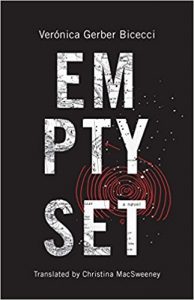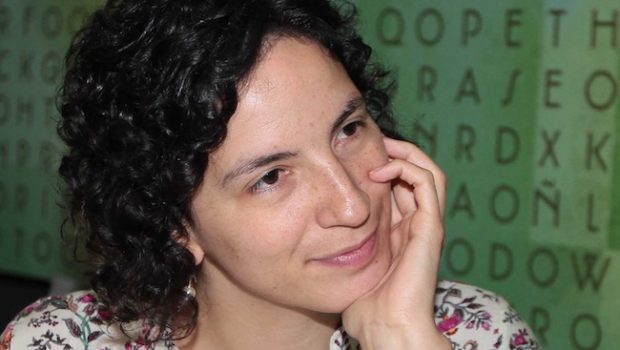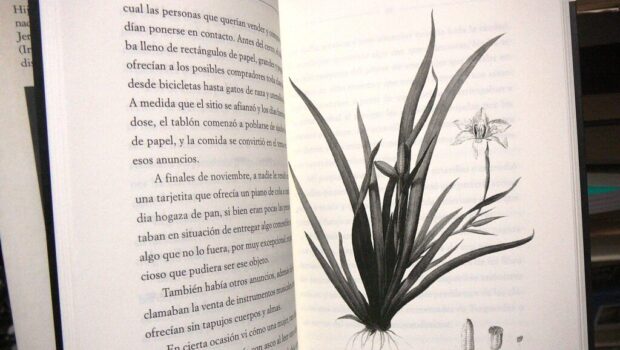Empty Set
Greg Walklin
Empty Set
By Verónica Gerber Bicecci
Coffee House Press
$16.95
Verónica dreams of reordering time. Living in a Mexico City apartment with her brother, she envisions “the past in a future so distant we never reach the moment of confronting it.” Though she shares “the bunker” with her sibling, she is still isolated and alone, trying to find a job and dealing with the disappearance of her mother. Empty Set, Verónica Gerber Bicecci’s novel, charts and diagrams Verónica’s solitary path.
Told in fragments, a number of things happen: Verónica breaks up with her visual artist boyfriend, who had a tattoo of himself pictured from far away, walking on a high wire; she is hired to organize the correspondence and writings of a deceased female author, and becomes interested in her son; she travels to New York, and to Argentina, where her mother was born; and she mathematically muses on the interactions and organizations of her life and the lives of those around her. Many of these events overlap, metaphorically and literally: for example, the frustrated female author whose work and correspondence Verónica collates shares a background with Verónica’s own mother, as both were refugees from Pinochet dictatorship; and her trips north and south raise similar feelings of loneliness. Characters appear and reappear—or perhaps, it seems, they may have just disappeared.
Full of contradictions, Verónica, to quote Whitman, contains multitudes. She writes love notes with the letters scrambled, but is scared about being misunderstood; she hides from images of her ex-boyfriend’s new inamorata, but sees the new woman everywhere. She finds refuge in eclectic pursuits, like dendrochronology. The world around her is indifferent, which seems to its default setting: “It’s surprising how little it takes to make the whole world believe your life is like everyone else’s.,” she narrates. Her alienation is both physical and existential. Verónica, it seems, is grasping but coming up only with air:
We always realize things afterwards. Loneliness is invisible, we go through it unconsciously, without knowing it. At least that’s true of the sort that I am talking about, it’s a kind of empty set that installs itself in the body, in language, and makes us unintelligible.
Gerber Bicecci’s writing is both existential (“We’re all waiting for what we can’t see to finally appear”) and sharply observational (one character “had a sad expression, but he laughed at anything and everything”). Christina MacSweeney’s translation ably renders Gerber Bicecci’s isolation, which in this particular case was complicated by a unique issue in her style. Addressing this, novel contains an afterward about “The I Problem,” which involved whether to use brackets—each character in the novel has an attaching symbol, such as “Mother[M] or “Tordo[T]”—when the novelist uses the word “I.” (Of course, in Spanish, it is possible, grammatically, to omit “Yo” altogether, but not quite in English.) Obviously thought through, the translator’s omission of “I” as much as possible in this translation underscores Verónica’s lack of self, perhaps a product of her mother’s disappearance. MacSweeney’s experience with these types of fragmentary novels shows; she also translated Valeria Luiselli’s wonderfully outré The Story of My Teeth.
Equally important to all of the words, however, are the illustrations and diagrams in Empty Set—including figures and representations of the characters in diagram form. As described on her website, Bicecci is an “artista que escribe,” or an “artist who writes”—the order being essential (somewhat similarly, Verónica’s ex-boyfriend is described as visual artist who would have preferred to be a writer).
It’s natural that with Empty Set, she has created a hybrid of two art forms: the book is littered with figures mapping the interconnections of the characters and demonstrating things the written word cannot quite detail. What could have been gimmicky isn’t, as the visuals are a fundamental part of the storytelling, and essential to its deeper layers. (A few times they are also funny.) About a third of the way through the novel, in fact, there is a rather complicated series of what best can be described as Venn diagrams—some shaded or partially shaded, some with dotted lines and some with solid lines—each representing various characters in the book, accompanied by the text, “Here’s where this story ends.” Of course, the order of what happens in this novel is only part of the puzzle the reader has to assemble, but this layer makes for the sort of fun one has trying to work out a Rubik’s Cube.
Empty Set is an ontological novel about ordering—in a broad sense—and about systems, and applying those to our lives. “There’s no recognizable cause,” Veronica states early on, “only effects.” A way of explaining our lives is that we create sets, we are part of sets, and if we view our lives in such a manner, we see how fundamental they are, just as sets are fundamental to mathematics and mathematical proofs. “A secret is like an invisible subset,” Gerber Bicecci writes, in one of the metaphor’s extensions. This way of looking at the world makes up the foundation for a great novel, in both senses of a good story and as something starkly original.
 Greg Walklin is an attorney and writer living in Lincoln, Nebraska. His book reviews have appeared in The Millions, Necessary Fiction, The Colorado Review, and the Lincoln Journal-Star, among other publications. He has also published several pieces of short fiction. Twitter: @gwalklin
Greg Walklin is an attorney and writer living in Lincoln, Nebraska. His book reviews have appeared in The Millions, Necessary Fiction, The Colorado Review, and the Lincoln Journal-Star, among other publications. He has also published several pieces of short fiction. Twitter: @gwalklin
©Literal Publishing
Posted: January 31, 2018 at 11:30 pm










